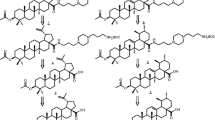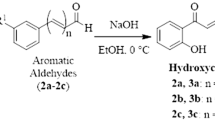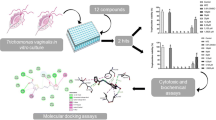Abstract
Trichomoniasis is the most common non-viral sexually transmitted disease worldwide and can lead to serious consequences in reproductive health, cancer, and HIV acquisition. The current approved treatment present adverse effects and drug resistance data on this neglected parasitic infection is underestimated. Chalcones are a family of molecules that present biological applications, such as activity against many pathogenic organisms including protozoan pathogens. Chalcone (1) and three amino-analogues (2–4) were synthesized by Claisen–Schmidt condensation reaction and had their activity evaluated against the parasitic protozoan Trichomonas vaginalis. This bioassay indicated the presence and position of the amino group on ring A was crucial for anti-T. vaginalis activity. Among these, 3′-aminochalcone (3) presented the most potent effect and showed high cytotoxicity against human vaginal cells. On the other hand, 3 was not able to exhibit toxicity against Galleria mellonella larvae, as well as the hemolytic effect on human erythrocytes. Trophozoites of T. vaginalis were treated with 3, and did not present significant reactive oxygen species (ROS) accumulation, but induced a significantly higher ROS accumulation in human neutrophils after co-incubation. T. vaginalis pyruvate:ferredoxin oxidoreductase (PFOR) and β-tubulin gene expression was not affected by 3.





Similar content being viewed by others
References
Alderete JF, Garza GE (1985) Specific nature of Trichomonas vaginalis parasitism of host cell surfaces. Infect Immun 50:701–708
Anthwal A, Rajesh UC, Rawat MS, Kushwaha B, Maikhuri JP, Sharma VL, Gupta G, Rawat DS (2014) Novel metronidazole-chalcone conjugates with potential to counter drug resistance in Trichomonas vaginalis. Eur J Med Chem 79:89–94
Böyum A (1968) Isolation of mononuclear cells and granulocytes from human blood. Isolation of monuclear cells by one centrifugation, and of granulocytes by combining centrifugation and sedimentation at 1 g. Scand J Clin Lab Invest Suppl 97:77–89
Browne N, Heelan M, Kavanagh K (2013) An analysis of the structural and functional similarities of insect hemocytes and mammalian phagocytes. Virulence 4(7):597–603
Büyükgüzel E, Büyükgüzel K, Snela M, Erdem M, Radtke K, Ziemnicki K, Adamski Z (2013) Effect of boric acid on antioxidant enzyme activity, lipid peroxidation, and ultrastructure of midgut and fat body of Galleria mellonella. Cell Biol Toxicol 29(2):117–129
Chen M, Zhai L, Christensen SB, Theander TB, Kharazmi A (2001) Inhibition of fumarate reductase in Leishmania major and L. donovani by chalcones. Antimicrob Agents Chemother 45:2023–2029
Cherpes TL, Wiesenfeld HC, Melan MA, Kant JA, Cosentino LA, Meyn LA, Hillier SL (2006) The associations between pelvic inflammatory disease, Trichomonas vaginalis infection, and positive herpes simplex virus type 2 serology. Sex Transm Dis 33:747–752
Cotch MF, Pastorek JG 2nd, Nugent RP, Hillier SL, Gibbs RS, Martin DH, Eschenbach DA, Edelman R, Carey JC, Regan JA, Krohn MA, Klebanoff MA, Rao AV, Rhoads GG (1997) Trichomonas vaginalis associated with low birth weight and preterm delivery. The Vaginal Infections and Prematurity Study Group. Sex Transm Dis 24(6):353–360
Das M, Manna K (2016) Chalcone scaffold in anticancer armamentarium: a molecular insight. J Toxicol 2016:7651047
Diamond LS (1957) The establishment of various trichomonads of animals and man in axenic cultures. J Parasitol 43:488–490
dos Santos O, de Vargas Rigo G, Frasson AP, Macedo AJ, Tasca T (2015) Optimal reference genes for gene expression normalization in Trichomonas vaginalis. PLoS One 10:e0138331
Feyereisen R (1999) Insect P450 enzymes. Annu Rev Entomol 44:507–533
Gauthier C, Legault J, Girard-Lalancette K, Mshvildadze V, Pichette A (2009) Haemolytic activity, cytotoxicity and membrane cell permeabilization of semi-synthetic and natural lupane- and oleanane-type saponins. Bioorg Med Chem 17:2002–2008
Grodstein F, Goldman MB, Cramer DW (1993) Relation of tubal infertility to history of sexually transmitted diseases. Am J Epidemiol 137:577–584
Ignasiak K, Maxwell A (2017) Galleria mellonella (greater wax moth) larvae as a model for antibiotic susceptibility testing and acute toxicity trials. BMC Res Notes 10(1):428
Iqbal H, Prabhakar V, Sangith A, Chandrika B, Balasubramanian R (2014) Synthesis, anti-inflammatory and antioxidant activity of ring-A-monosubstituted chalcone derivatives. Med Chem Res 23:4383–4394
Karimi-Sales E, Mohaddes G, Alipour MR (2018) Chalcones as putative hepatoprotective agents: preclinical evidence and molecular mechanisms. Pharmacol Res 129:177–187
Kavanagh K, Fallon JP (2010) Galleria mellonella larvae as models for studying fungal virulence. Fungal Biol Rev 24:79–83
Kirkcaldy RD, Augostini P, Asbel LE, Bernstein KT, Kerani RP, Mettenbrink CJ, Pathela P, Schwebke JR, Secor WE, Workowski KA, Davis D, Braxton J, Weinstock HS (2012) Trichomonas vaginalis antimicrobial drug resistance in 6 US cities, STD surveillance network, 2009-2010. Emerg Infect Dis 18:939–943
Kissinger P, Adamski A (2013) Trichomoniasis and HIV interactions: a review. Sex Transm Infect 89:426–433
Kulda J (1999) Trichomonads, hydrogenosomes and drug resistance. Int J Parasitol 29:199–212
Land KM, Clemens DL, Johnson PJ (2001) Loss of multiple hydrogenosomal proteins associated with organelle metabolism and high-level drug resistance in trichomonads. Exp Parasitol 97:102–110
Livak KJ, Schmittgen TD (2001) Analysis of relative gene expression data using real-time quantitative PCR and the 2(−Delta Delta C(T)) method. Methods 25:402–408
Mahapatra DK, Bharti SK, Asati V (2015) Chalcone scaffolds as anti-infective agents: structural and molecular target perspectives. Eur J Med Chem 101:496–524
Mirzaei H, Emami S (2016) Recent advances of cytotoxic chalconoids targeting tubulin polymerization: synthesis and biological activity. Eur J Med Chem 121:610–639
Mosmann T (1983) Rapid colorimetric assay for cellular growth and survival: application to proliferation and cytotoxicity assays. J Immunol Methods 65:55–63
Noël JC, Fayt I, Romero-Munoz MR, Simon P, Engohan-Aloghe C (2010) High prevalence of high-risk human papillomavirus infection among women with Trichomonas vaginalis infection on monolayer cytology. Arch Gynecol Obstet 282:503–505
Popoola OK, Marnewick JL, Rautenbach F, Ameer F, Iwuoha EI, Hussein AA (2015) Inhibition of oxidative stress and skin aging-related enzymes by prenylated chalcones and other flavonoids from Helichrysum teretifolium. Molecules 20:7143–7155
Santos MB, Pinhanelli VC, Garcia MAP, Silva G, Baek SJ, França SC, Fachin AL, Martins M (2017) Antiproliferative and pro-apoptotic activities of 2′- and 4′-aminochalcones against tumor canine cells. Eur J Med Chem 138:884–889
Secor WE, Meites E, Starr MC, Workowski KA (2014) Neglected parasitic infections in the United States: trichomoniasis. Am J Trop Med Hyg 90:800–804
Singh G, Arora A, Mangat SS, Rani S, Kaur H, Goyal K, Sehgal R, Maurya IK, Tewari R, Choquesillo-Lazarte D, Sahoo S, Kaur N (2016) Design, synthesis and biological evaluation of chalconyl blended triazole allied organosilatranes as giardicidal and trichomonacidal agents. Eur J Med Chem 108:287–300
Song HO, Shin MH, Ahn MH, Min DY, Kim YS, Ryu JS (2008) Trichomonas vaginalis: reactive oxygen species mediates caspase-3 dependent apoptosis of human neutrophils. Exp Parasitol 118:59–65
Sutcliffe S, Neace C, Magnuson NS, Reeves R, Alderete JF (2012) Trichomonosis, a common curable STI, and prostate carcinogenesis--a proposed molecular mechanism. PLoS Pathog 8:e1002801
Vieira PB, Tasca T, Secor WE (2017) Challenges and persistent questions in treatment of trichomoniasis. Curr Top Med Chem 17:1249–1265
Viikki M, Pukkala E, Nieminen P, Hakama M (2000) Gynaecological infections as risk determinants of subsequent cervical neoplasia. Acta Oncol 39:71–75
World Health Organisation (2012) Global incidence and prevalence of selected curable sexually transmitted infections – 2008. WHO, Geneva
Wang Y, Gao H, Na XL, Dong SY, Dong HW, Yu J, Jia L, Wu YH (2016) Aniline induces oxidative stress and apoptosis of primary cultured hepatocytes. Int J Environ Res Public Health 13:1188
Zhai L, Blom J, Chen M, Christensen SB, Kharazmi A (1995) The antileishmanial agent licochalcone a interferes with the function of parasite mitochondria. Antimicrob Agents Chemother 39:2742–2748
Zhai L, Chen M, Blom J, Theander TG, Christensen SB, Kharazmi A (1999) The antileishmanial activity of novel oxygenated chalcones and their mechanism of action. J Antimicrob Chemother 43:793–803
Zhuang C, Zhang W, Sheng C, Zhang W, Xing C, Miao Z (2017) Chalcone: a privileged structure in medicinal chemistry. Chem Rev 117:7762–7810
Zeraik ML, Ximenes VF, Regasini LO, Dutra LA, Silva DH, Fonseca LM, Coelho D, Machado SA, Bolzani VS (2012) 4'-Aminochalcones as novel inhibitors of the chlorinating activity of myeloperoxidase. Curr Med Chem 19:5405–5413
Funding
Conselho Nacional de Desenvolvimento Científico e Tecnológico (CNPq/Brazil), Marine Biotechnology Program (A.J.M., RedeMarAtivo, grant 408578/2013–0) and Universal Program (D.S.T., grant 443150/2014–1) supported this study. A.J.M., L.O.R, and T.T. thank CNPq for researcher fellowships (grants 303353/2016–3, 306251/2016–7, 312292/2017–1, respectively).
Author information
Authors and Affiliations
Corresponding author
Ethics declarations
Conflict of interest
The authors declare that they have no conflict of interest.
Additional information
Handling Editor: Julia Walochnik
Publisher’s Note
Springer Nature remains neutral with regard to jurisdictional claims in published maps and institutional affiliations.
Electronic supplementary material
ESM 1
(PDF 1187 kb)
Rights and permissions
About this article
Cite this article
Trein, M.R., Rodrigues e Oliveira, L., Rigo, G.V. et al. Anti-Trichomonas vaginalis activity of chalcone and amino-analogues. Parasitol Res 118, 607–615 (2019). https://doi.org/10.1007/s00436-018-6164-4
Received:
Accepted:
Published:
Issue Date:
DOI: https://doi.org/10.1007/s00436-018-6164-4




